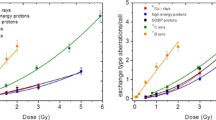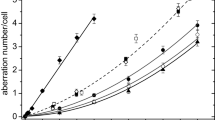Abstract
Experimental data for the induction of dicentric chromosomes in phytohemagglutinin (PHA)-stimulated human T lymphocytes by 241Am alpha-particles obtained by Schmid et al. have been analyzed in the light of biophysical theory. As usual in experiments with alpha-particles, the relative variance of the intercellular distribution of the number of aberrations per cell exceeds unity, and the multiplicity of the aberrations per particle traversal through the cell is understood as the basic effect causing this overdispersion. However, the clearly expressed dose dependence of the relative variance differs from the dose-independent relative variance predicted by the multiplicity effect alone. Since such dose dependence is often observed in experiments with alpha-particles, protons, and high-energy neutrons, the interpretation of the overdispersion needs to be supplemented. In a new, more general statistical model, the distribution function of the number of aberrations is interpreted as resulting from the convolution of a Poisson distribution for the spontaneous aberrations with the overdispersed distributions for the aberrations caused by intratrack or intertrack lesion interaction, and the fluctuation of the cross-sectional area of the cellular chromatin must also be considered. Using a suitable mathematical formulation of the resulting dose-dependent overdispersion, the mean number λ 1 of the aberrations produced by a single particle traversal through the cell nucleus and the mean number λ 2 of the aberrations per pairwise approach between two alpha-particle tracks could be estimated. Coefficient α of the dose-proportional yield component, when compared between 241Am alpha-particle irradiation and 137Cs gamma-ray exposure, is found to increase approximately in proportion to dose-mean restricted linear energy transfer, which indicates an underlying pairwise molecular lesion interaction on the nanometer scale.
Similar content being viewed by others
Author information
Authors and Affiliations
Additional information
Received: 17 December 1996 / Accepted in revised form: 20 April 1997
Rights and permissions
About this article
Cite this article
Greinert, R., Harder, D. Biophysical analysis of the dose-dependent overdispersion and the restricted linear energy transfer dependence expressed in dicentric chromosome data from alpha-irradiated human lymphocytes. Radiat Environ Biophys 36, 89–95 (1997). https://doi.org/10.1007/s004110050059
Issue Date:
DOI: https://doi.org/10.1007/s004110050059




